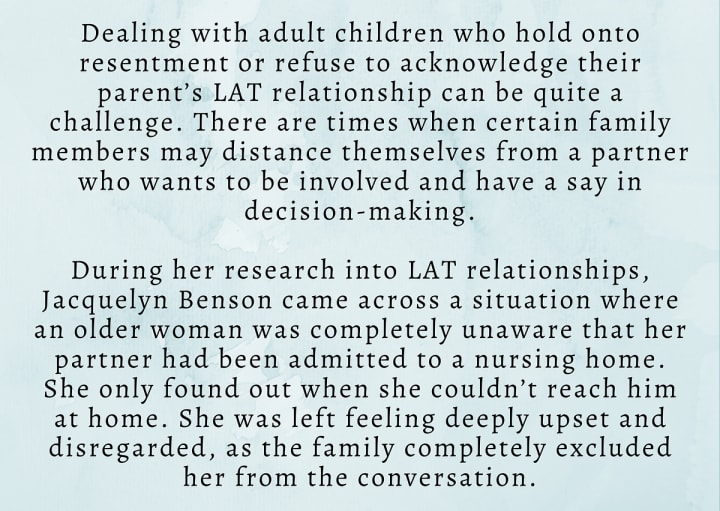Living Apart Together: The Secret To A Happy Relationship?
The new dating trend that is saving relationships

What is it?
So, what exactly is Living Apart Together (LAT)? Essentially, it's a relationship arrangement where two individuals who are romantically involved with each other choose to live in separate homes. This can mean living in different neighbourhoods, cities, or even countries.
This unconventional arrangement has become increasingly popular over the years as more and more couples opt to marry later or choose not to marry at all.
While it's certainly not for everyone, by living apart, couples have the freedom to maintain their personal space, lifestyle, and independence while still enjoying the emotional connection and support of a committed relationship.
How long has it been around?
LAT relationships are not a new concept, but over the last few decades, they've gained more visibility and acceptance in modern society, especially in Western countries.
The term was initially coined by Dutch journalist Michel Berkiel in 1978 and later popularised in the United States in 2004 by Irene Levin's insightful article in the academic journal Current Sociology.
While LAT relationships have always been around in one form or another, the increasing acceptance of this trend is due primarily to changing social norms and perceptions, globalisation of the workforce, a better understanding of what constitutes a healthy relationship, and the increased use of technology.
"The reason more and more couples choose separation marriage is because they want to maintain their lifestyle," says Hiromi Takeda, who adopted a separation marriage with her husband, Hidekazu Takeda, to "combine the benefits of both being married and being single."
Most importantly, the idea that you must cohabit with your partner to be considered in a serious relationship has shifted, and individuals who don't feel cohabitation is necessary to show commitment are free to choose other options. The freedom to make these choices also provides a sense of empowerment to individuals who would instead create and design their own rules for their relationships.
Why do couples live apart?
So why is LAT becoming a more popular choice for couples? Well, it combines the best of both worlds. Couples can maintain their individual lives, independence, and privacy while still enjoying the benefits of a committed relationship.
After all, living together can be a daunting prospect for some couples. Maybe they're not quite ready to relinquish their independence, or they prefer to take things slowly in a new situation. And who can blame them? Living with a partner can be quite a challenge. It requires a lot of compromise, especially when dealing with differences in lifestyle. There's a lot to navigate, from keeping the house clean to managing sleep schedules, parenting styles, political views, travel preferences, socialising habits, religious beliefs, and even eating habits.

And it's not just personal space you give up when moving in with a loved one, but emotional space as well. However, living in separate homes allows partners to dedicate time and space to developing their passions, hobbies, and careers without feeling guilty about neglecting their significant other.
It's worth noting that the success of living apart in relationships can differ depending on various social and cultural factors. This kind of relationship might be viewed as a stepping stone towards marriage in certain cultures, such as Romania or Bulgaria. However, in countries like France, where the family structure is more modern, living apart together is seen as an alternative to the traditional family setup.
"You just make a point of every time you're together being special because you don't have a lot of it." - Heather MacDonald told The New Reality.
Conversely, for single parents, Living Apart Together arrangements allow them to introduce their children to their new partner slowly and carefully, prioritising their well-being. Not only that, but LAT also provides a welcome option for individuals caring for elderly parents or shouldering similar caregiving responsibilities. With LAT, they can support and remain devoted to their loved ones without sacrificing privacy and independence.
The rise in older couples embracing LAT
Living Apart Together relationships have become increasingly popular among older couples in recent years. But this trend shouldn't come as a surprise, given the increase in divorce rates and the growing number of ageing baby boomers. Like anyone else, they want to have their cake and eat it too. They want the freedom to pursue their interests while maintaining committed partnerships.
This is particularly true for older couples who have found themselves in a serious relationship for the second time. Having experienced divorce or the loss of a partner, they understand the challenges that can arise from living with someone who isn't the right fit. To avoid repeating past mistakes, these couples choose an LAT relationship. It allows them to take things at their own pace and avoids feeling rushed into shared living.
"It may not be for everyone, but it does have its benefits, especially for older couples who might be set in their ways and don't want to change. They can maintain their independence, lifestyle and social circle, while enjoying all the benefits of a caring, supportive relationship." - Melissa Ferrari, psychologist and relationship counsellor.
In a study conducted in 2016, researchers Jacquelyn Benson and Marilyn Coleman from the University of Missouri dove into the world of late-life cohabitation. They interviewed 25 individuals aged 60 to 88 to gain insights into their experiences and perspectives on being in LAT relationships.
The findings, published in the Journal of Marriage and Family, shed light on a desire among elderly individuals to maintain meaningful connections while valuing personal freedom, social interactions, hobbies, and financial independence. Interestingly, those who had gone through divorce or unsatisfying marriages were particularly mindful about committing fully to daily closeness, often preferring to maintain a certain level of distance.
Notably, the study uncovered that some women who had previously shouldered caregiving responsibilities for ill parents or partners now wished to avoid taking on similar roles or the burdens associated with managing a household. One woman, for example, chose to focus on saving for her own future needs rather than using her savings to support her partner's potential nursing home expenses.

To add to the above, health reasons are one of the driving forces behind the decision to live separately. This is particularly relevant for older women who may have reservations about pursuing a romantic relationship that could escalate into a full-time caregiving responsibility. Instead, they prefer to meet their social needs by nurturing their existing bonds with family and friends, steering clear of the potential strain of taking on the carer role for a new partner.
Let's take a moment to consider Margaret Widuckel, a 75-year-old widowed nurse from Melbourne, Australia. In a 2021 interview with the New York Times, she mentioned that while she occasionally misses having a romantic partner, she has genuine concerns about being thrust into a caregiver role. Margaret witnesses firsthand how her friends with frail husbands are unable to pursue their own interests, and their conversations primarily revolve around their husbands' medical issues.
On the flip side, let me tell you about Nomi Glazier, an extraordinary 87-year-old woman bursting with energy who has found herself in a delightful new relationship with Mac, an active 90-year-old. After the passing of her first husband, she dedicated over two decades of her life to living with and taking care of her next partner, who unfortunately succumbed to illness in her home.
However, this time around, Glazier is taking a different approach.
Glazier mentioned that Mac has aced what she affectionately calls the "senior alphabet test." As toddlers are busy learning their ABCs, seniors like them also have important lessons to navigate: Respect, Space, and Trust.
For Glazier, having personal space involves living in separate condos that are conveniently located within the same building. They appreciate each other's company when they want to be together, but they also understand the importance of having personal space. When the couple is physically apart and enjoying their own activities, Glazier sees it as a well-deserved "vacation."
Disadvantages of a LAT relationship
Speaking of difficulties, one of the most obvious drawbacks is the lack of physical proximity. When two people are not living together, you can't simply walk into their room for a conversation, enjoy cosy moments on the couch, or have spontaneous moments of intimacy.
In the same way, planning visits in advance, considering transportation, and ensuring both partners are available and willing to spend time together requires more effort and communication compared to cohabiting. For some couples, this lack of spontaneity can even be a dealbreaker. Living apart might mean missing out on those small, spontaneous interactions that make a relationship fun and exciting, like deciding to cook dinner together or spontaneously watching a movie.
Moreover, living separately can be tough on the partner, who may feel lonely or unsafe in their own home. The physical distance can also present certain safety risks or emergencies that may take longer to resolve.

Money can be another concern for couples engaging in LAT. For example, dealing with the expenses of maintaining two households and the constant back-and-forth between them can present financial difficulties.
Aside from the challenges mentioned above, there is also the matter of how outsiders perceive and pass judgment on a LAT relationship. You may encounter raised eyebrows and sceptical inquiries when you disclose that you are in a LAT relationship.
After all, many individuals still associate living together with commitment, stability, and maturity, which can lead them to view a LAT relationship as a sign of immaturity, lack of trust, or avoidance of responsibility. Integrating into social or family circles may be more difficult, as people may assume you are not a "real" couple.
Want to give it a go?
To build a successful LAT relationship, it's crucial to define the nature of your relationship right from the start. Open and honest communication between you and your partner is vital. Discuss your expectations, such as exclusivity, frequency of seeing each other, financial arrangements, and the possibility of eventually living together.
Remember that in a LAT relationship, living apart doesn't hinder your ability to plan for the future. Open discussions about long-term goals and finding ways to work towards them as a team is essential. Addressing these questions beforehand will help avoid any potential misunderstandings along the way.

Maintaining the passion in a LAT relationship can be challenging, but there are many ways to keep the spark alive.
One approach is to use technology to bridge the distance between you and your partner by sharing daily activity photos, sending thoughtful voice notes during work breaks, and exploring apps that allow you to enjoy movies or games together.
If you want to add a touch of nostalgia to your relationship, consider surprising your partner with thoughtful care packages or heartfelt handwritten letters. Dive into the same book to spark conversations, send them a delivery of their favourite flowers, or plan exciting trips and getaways to look forward to. Remember, just because you're living separately doesn't mean you can't create memorable experiences together as a couple, virtually and in person.
"He was moving here from another country, and we felt it was important that he have a chance to build up his own life and his own friends," says Annie Fox regarding her husband, Nash Fox.
Lastly, while it is crucial to communicate effectively and spend quality time together, it is equally essential to maintain independence. Making sure to prioritise time for yourself, pursue your interests, and keep your living space can all contribute to a healthy and successful LAT relationship.
Conclusion
Living Apart Together relationships may not be everyone's cup of tea, but for those who are open to the idea, it can truly enrich their relationship. It's essential to remember that LAT does not imply a lack of love or commitment; instead, it provides couples with the freedom and independence they may need to maintain their happiness, personal growth, and a positive sense of self.
About the Creator
Chelsea Rose
I never met a problem I couldn't make worst.






Comments
There are no comments for this story
Be the first to respond and start the conversation.